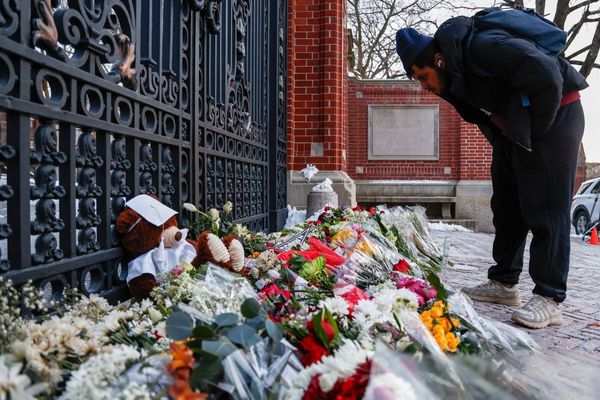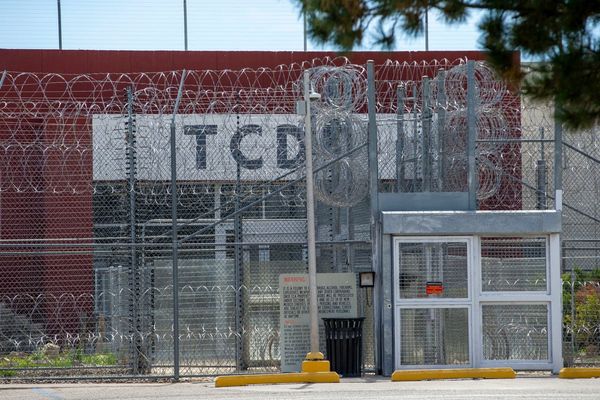
First came the sound of drones. Then a boom that rattled windows. Shortly after that, two columns of black smoke rose over the Shebelinka gas processing plant in Ukraine’s Kharkiv region. Towering flames threatened storage tanks.
A refinery worker emerged from the site. Russian drones and missiles had struck the plant at 4.30am, he said. For now there was nothing for the fire crews to do but to stand back and watch.
It was not just Kharkiv that was hit overnight. Over the course of another night of wearily familiar alarms, Russian air raids struck across the country.
Moscow has intensified its aerial warfare in recent months, launching more than 3,000 drones, 92 missiles and almost 1,400 glide bombs against Ukraine between 5 October and 12 October alone.
Near their base in northern Ukraine, air defence troops attached to the territorial brigade reflect on the difficulty of shooting down the Russian drones and missiles that fly through their sector, a task they admit that has become ever harder.
With each air alert – sometimes six times a day – soldiers with pick-ups and machine guns have 10 minutes to reach their firing points and track the trajectory of the incoming munitions on a tablet.
It is only at about a distance of 1km that the gunner can see the target. Then there is less than a minute, sometimes much less, to shoot it down.
“It’s really hard. If it is flying at a height of 1,500 metres it’s like trying to hit the head of a match,” said Yury Dovgan, an air defence soldier. “And then the gunner needs to hit the drone’s engine or explosive payload.”
Successes are far fewer than they would hope, even with 20 to 60 drones coming daily through their sector from Russia’s Bryansk region and via Belarus’s airspace. But between them and Kyiv are more air defence units.
Dovgan said the stress comes not from the maddeningly short window to shoot down the drones, but awareness of what it means to miss.
The war in the air has become increasingly significant in the past 18 or so months as the conflict on the ground has become bogged down.
On Friday the Ukrainian president, Volodymyr Zelenskyy, will be in Washington DC to make the case for US supply of long-range Tomahawk missiles that would allow Ukraine to strike deep into Russian territory – a prospect that appears to have dimmed since a call between Donald Trump and Vladimir Putin on Thursday.
“The key to success and victory is in the sky,” said Yury Ignat, a Ukrainian air force spokesperson. “But the outcome won’t just turn in the air, but on innovation.”
While Ignat cautions against the usefulness of headline statistics – not least because of Russia’s widespread use of decoy drones in mass attacks that muddies the picture – he is clear about the trajectory.
“Russia is breaking its own records for the number of munitions being used in these attacks,” he said. “Through August and September we have seen massive attacks every week.”
After the poor performance of Russia’s air force early in the war, Moscow has adapted, employing effective and evolving tactics for use in aerial bombardment, even as Ukraine has scored its own successes.
In recent months, huge Russian air raids have been launched on Ukrainian cities and key infrastructure like energy plants. Attacks comprise of hundreds of drones at a time, combined with smaller numbers of ballistic missiles.
In the largest raid, earlier this month, more than 600 munitions were used.
On the frontlines in Ukraine’s east, Russia has also sharply increased the use of glide bombs to target Ukrainian positions. At the same time, a change in both tactics and capabilities has made Russian air assaults more potent.
In their bunker at the territorial brigade’s base, well hidden in a forest, major Oleskandr Fouchek, the commander of the air defence unit, and his colleague Yaroslav Tristan described the challenges.
“First, the drones are flying higher. Earlier in the war we would see them flying at a height of 500-800 metres, now they will often start at 1500 metres,” said Fouchek.
“The speed has increased too from 150-160 kilometres an hour to now well over 200 kilometres an hour. It’s a game of cat and mouse,” added Tristan. “The Russians learn where our positions are when we shoot them down. So they’ll fly higher where they think we are, and we have to move our positions.”
Ukraine’s ability to defend against the air attacks has become an increasingly political issue.
After the heavy Russian air raid that plunged Kyiv into blackouts on 10 October, Zelenskyy voiced concerns about the protection of Kyiv’s energy infrastructure, saying he was “not satisfied” with the current situation. It appeared that the Ukrainian president was blaming the city’s mayor, Vitali Klitschko, with whom he has a fractious relationship.
For his own part, after the same raid, Ukraine’s commander-in-chief Oleksandr Syrskyi insisted the country’s air defences are about 74% effective, but still required improvement.
Justin Bronk, an airpower and technology research fellow at the Royal United Services Institute, has been studying the developing air war.
“I think it is one of the areas in the conflict where we have seen the most significant change in the past 18 months,” he said. “While there has been a lot of focus in commentary on the adoption of FPV drones on the battlefield, one of the things that is most impacting Ukraine’s ability to hold the line is Russia’s use of hundreds of glide bombs a week, largely delivered by SU-34s to smash into positions.
“They can keep smashing until those positions have gone. They have also got better at reprogramming in flight. That is a step-change in the impact that Russian tactical aviation is having on the frontlines.”
On the drone front too, Bronk sees Russia “making better dynamic use of the Shahed drones it is now mass producing”, adding: “They are refining route plans and identifying air defence sites.”
He notes too that Russia’s use of its missiles has become more effective, mentioning a variant of the Iskander ballistic missile equipped with decoys that can be released in the terminal phase of its flight and have the ability to manoeuvre.
“It’s not surprising after hundreds and hundreds of engagements, Russia has learned a lot about what makes intercepts by Patriot anti-missile batteries less likely,” Bronk said.
Ukraine too has adapted its offensive tactics.
Frequent long range strikes on Moscow’s oil refineries have created fuel shortages and damaged Russia’s economy. Raids on Russian airbases – including the complex Spider’s Web drone attack – have forced Russia to relocate its bombers ever further away from Ukraine’s borders.
“We are destroying [Russian] facilities involved in the production of fuel, lubricants, explosives, and other key components of Russia’s military-industrial complex,” Ukraine’s military chief Syrskyi said last week.
Assessing the state of play, Bronk addressed a vexed and long-debated question: whether air power alone can define the outcome of this conflict.
“I would say air power is not likely to win the war in Ukraine, but it could lose it,” he said. “Ukraine has an inherent limitation of capacity and Russia has an enormous air defence capability. The concern must be that Russia gains an air superiority, and ascendancy beyond where it is now. You have to keep up to avoid losing.”
At hospital 13 in Kharkiv, hit by a Russian glide bomb in recent days for the second time in seven months, the damage wreaked by the air war was plain to see: shattered wards with blown out doors and windows, patients injured by flying glass, and hospital vehicles turned to crushed scrap metal.
“There were a hundred staff and patients here when the attack happened,” said Alex Datsenko, the medical director. “It’s getting worse. There are more glide bombs and drones hitting the city. The Russians couldn’t win with tanks. Now they are trying to intimidate the population.”







